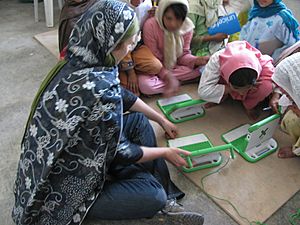Human–computer interaction facts for kids
Human-computer interaction (often called HCI) is a cool area of computer science. It's all about how people like you and me use and interact with computers. Think about how you use your phone, tablet, or computer. HCI looks at how these devices are designed so they are easy and fun for us to use.
This field focuses on making sure that the user interface (what you see and click on) is clear and helpful. It also looks at how we can make computers understand us better, whether through touch, voice, or even gestures. The goal is to make technology work smoothly with human needs and abilities.
Contents
What is Human-Computer Interaction?
HCI is a field that mixes ideas from many different areas. It brings together computer science, psychology, design, and even sociology. The main idea is to make technology that is not just powerful, but also easy and enjoyable for people to use.
Imagine you're playing a video game. HCI principles are behind how the controls feel, how the menus are laid out, and how the game responds to your actions. It's about creating a good experience for the user.
Why is HCI important?
HCI is super important because almost everyone uses computers every day. From checking the weather on your phone to doing homework on a laptop, technology is everywhere. If these tools are hard to use, it can be frustrating and waste a lot of time.
Good HCI design means:
- Easier learning: New apps or devices are simple to figure out.
- Faster tasks: You can get things done quickly without getting lost.
- Fewer mistakes: The design helps you avoid errors.
- More enjoyment: Using technology becomes a pleasant experience.
For example, think about how easy it is to send a text message or find a video online. That's thanks to good HCI design making those tasks simple and intuitive.
Designing for Users
A big part of HCI is understanding the people who will use the technology. Designers don't just think about what a computer can do. They also think about what people need, how they think, and what they find easy or difficult.
Understanding User Needs
Before designing anything, HCI experts try to understand who the users are. Are they kids, adults, or older people? What are their skills? What do they want to achieve with the computer?
They might:
- Observe people: Watch how people currently do tasks.
- Interview users: Ask people about their experiences and frustrations.
- Create user personas: Make up imaginary users with specific traits to guide design.
This helps them create technology that truly solves problems for real people.
Creating User Interfaces
The user interface (UI) is what you see and interact with on a screen. It includes buttons, menus, icons, and text. HCI designers work hard to make UIs clear, attractive, and easy to navigate.
They consider things like:
- Layout: Where everything is placed on the screen.
- Colors and fonts: How they affect readability and mood.
- Feedback: How the system tells you it understood your action (e.g., a button changing color when you click it).
- Accessibility: Making sure people with different abilities can still use the technology.
A well-designed UI makes using a computer feel natural and effortless.
How We Interact with Computers
Over time, the ways we interact with computers have changed a lot. HCI studies all these different methods.
Traditional Interactions
For a long time, we mainly used a keyboard and a mouse to interact with computers.
- Keyboard: Used for typing text and commands.
- Mouse: Used for pointing, clicking, and dragging things on the screen.
These methods are still very common, especially for tasks that involve a lot of typing or precise control.
Newer Ways to Interact
As technology has grown, so have the ways we can talk to our devices.
- Touchscreens: You can tap, swipe, and pinch directly on the screen. This is common on phones and tablets.
- Voice commands: You can speak to your device, like asking a smart speaker to play music or a phone to set a timer.
- Gestures: Some systems can understand hand movements or body language, like waving your hand to control a game.
- Virtual and Augmented Reality: These technologies let you interact with digital worlds or overlay digital information onto the real world.
HCI researchers are always looking for even newer and more natural ways for humans and computers to work together.
The Future of HCI
The field of HCI is always growing and changing. As technology gets smarter, our interactions with it will become even more seamless.
Smart Environments
Imagine your home or classroom being "smart." Lights might turn on when you enter a room, or your computer might know what you need before you even ask. HCI is helping to design these smart environments where technology blends into our lives.
Personalized Experiences
Future systems might learn about your habits and preferences. They could then adjust themselves to give you a truly personalized experience. For example, a learning app might change its lessons based on how you learn best.
Ethical Considerations
As HCI develops, it's also important to think about the ethical side. How do we make sure technology is fair, private, and doesn't cause harm? HCI experts consider these questions to build responsible and helpful technology for everyone.
Images for kids
See also
 In Spanish: Interacción persona-computadora para niños
In Spanish: Interacción persona-computadora para niños




